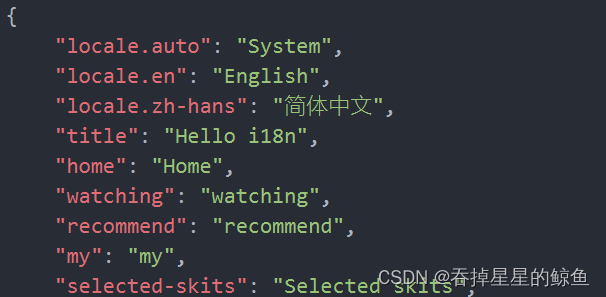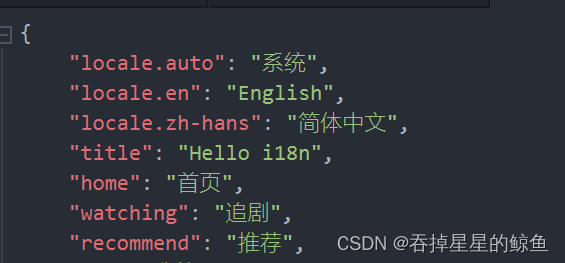您现在的位置是:首页 >学无止境 >使用uniapp开发国际化---app,vue,nvue网站首页学无止境
使用uniapp开发国际化---app,vue,nvue
简介使用uniapp开发国际化---app,vue,nvue
插件市场下载示例
项目使用
main.js引入
// 国际化 json 文件,文件内容详见下面的示例
import en from './en.json'
import zhHans from './zh-Hans.json'
import zhHant from './zh-Hant.json'
const messages = {
en,
'zh-Hans': zhHans,
'zh-Hant': zhHant
}
let i18nConfig = {
locale: uni.getLocale(),// 获取已设置的语言
messages
}
// VUE2
// #ifndef VUE3
import Vue from 'vue'
import VueI18n from 'vue-i18n'// v8.x
Vue.use(VueI18n)
const i18n = new VueI18n(i18nConfig)
Vue.config.productionTip = false
App.mpType = 'app'
const app = new Vue({
i18n,
...App
})
app.$mount()
// #endif
// VUE3
// #ifdef VUE3
import { createSSRApp } from 'vue'
import { createI18n } from 'vue-i18n'// v9.x
const i18n = createI18n(i18nConfig)
export function createApp() {
const app = createSSRApp(App)
app.use(i18n)
return {
app
}
}
// #endif
创建文件

en.json----"自定义key":"英文"

zh-Hans.json----"自定义key":"中文"

注意:json文件中的名称需要中英文对应。
index.js
import en from './en.json'
import zhHans from './zh-Hans.json'
export default {
en,
'zh-Hans': zhHans,
}页面中使用
vue页面模板使用----$t('')
<template>
<view class="container">
<-- index.title 为json文件中 自定义key -->
<view class="title">{{$t('index.title')}}</view>
</view>
</template>nvue页面模板使用----t('')
import messages from '../../locale/index.js'
import {
initVueI18n
} from '@dcloudio/uni-i18n'
const {
t
} = initVueI18n(messages) // 初始化
created() {
const {
t
} = initVueI18n(messages);
this.t = t;
},pages.json 使用 ----%index.title%
{
"pages": [
{
"path": "pages/index/index",
"style": {
"navigationBarTitleText": "%index.title%" // locale目录下 语言地区代码.json 文件中定义的 key,使用 %% 占位
}
}
],
"tabBar": {
"list": [{
"pagePath": "pages/index/index",
"text": "%index.home%"
}
]
}
}data中使用---this.$t('')
data() {
return {
// json 文件中定义的 key
name: this.$t('dhjl'),
}
},切换语言---在某一个页面写入
<view class="" style="margin-top: 20px;margin-left: 290px;">
<u-radio-group v-model="radiovalue1" placement="column">
<u-radio :customStyle="{marginBottom: '8px'}" v-for="(item, index) in locales" :key="index"
:label="item.text" :name="item.text" @change="onLocaleChange(item)">
</u-radio>
</u-radio-group>
</view>computed:{
locales() {
return [{
text: this.$t('locale.en'),
code: 'en'
},
{
text: this.$t('locale.zh-hans'),
code: 'zh-Hans'
}
]
}
},// 更改语言
onLocaleChange(e) {
if (this.isAndroid) {
uni.showModal({
content: this.$t('index.language-change-confirm'),
success: (res) => {
if (res.confirm) {
uni.setLocale(e.code);
}
}
})
} else {
uni.setLocale(e.code);
this.$i18n.locale = e.code;
}
},启动项目,就可以成功切换语言了。
如果遇到切换语言的时候不能全局切换,可以尝试注释掉以下代码。

以上就是关于在uniapp中使用国际化的一些说明,内容不多,操作简单。
风语者!平时喜欢研究各种技术,目前在从事后端开发工作,热爱生活、热爱工作。





 U8W/U8W-Mini使用与常见问题解决
U8W/U8W-Mini使用与常见问题解决 分享几个国内免费的ChatGPT镜像网址(亲测有效)
分享几个国内免费的ChatGPT镜像网址(亲测有效) stm32使用HAL库配置串口中断收发数据(保姆级教程)
stm32使用HAL库配置串口中断收发数据(保姆级教程) QT多线程的5种用法,通过使用线程解决UI主界面的耗时操作代码,防止界面卡死。...
QT多线程的5种用法,通过使用线程解决UI主界面的耗时操作代码,防止界面卡死。... SpringSecurity实现前后端分离认证授权
SpringSecurity实现前后端分离认证授权